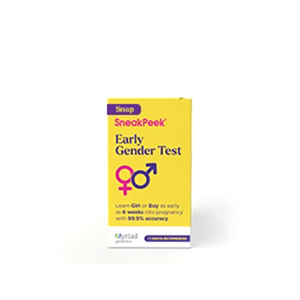Published on May 2nd, 2023 and Updated on February 29th, 2024
Check out SneakPeek Gender Test to find out your baby’s gender as early as 6 weeks at over 99% accuracy1!
As momentous as it is to see that baby pink YES on an at-home pregnancy test, many women find that it’s during their first prenatal care visit that their pregnancy truly starts to feel real.
Exactly what happens at your first prenatal appointment?
This first-trimester prenatal is primarily designed to check your health vitals and give you the opportunity to discuss how you can start your pregnancy on the right foot. It’s generally recommended you book your first prenatal as soon as you discover you’re expecting, and no sooner than 8 weeks into your pregnancy.
Once you’ve set a date with your care provider, check out our breakdown of what to expect from your first appointment (and how to prepare for it like a pro).
#1 Making It (Your Pregnancy!) Official
Before anything else, your care provider has to confirm your pregnancy. This is typically carried out in one of two ways:
- A urine test
- A blood test (these may yield slightly more accurate results)
Both methods screen for the hormone hCG, or human chorionic gonadotropin, which indicates that your body has started growing a baby in your belly.
Your provider may also request further testing to deduce the gestational age of your baby. Pregnancies are dated by using the first day of your last menstrual cycle—not the day on which your baby was conceived. Generally speaking, gestational age falls around 2 weeks earlier than the day a sperm fertilizes an egg (conception).
#2 Reviewing Your Medical History and Performing a Physical Exam
After your pregnancy has been confirmed, your healthcare provider will ask you some questions to assess your medical history. They may inquire about:
- Past pregnancies, pregnancy outcomes, and complications (if applicable)
- Preexisting medical conditions
- Past or planned surgeries
- Current medications or supplements
- Family medical history
- Allergies
You’ll receive a hands-on physical exam to determine a few key markers of your health, including:
- Your weight and height – Weight is a critical factor in predicting birth outcomes. While a higher maternal weight may put you and your baby at risk of conditions like gestational diabetes, being underweight can jeopardize your baby’s nutritional needs. Knowing your height and weight will also give your doctor a sense of healthy weight gain milestones for your prenatal care plan (more on that later).
- Your blood pressure and heart rate – A suite of major cardiovascular shifts occur in early pregnancy to accommodate your growing fetus—blood volume increases by 50% to 60%, while maternal heart rate accelerates to up to 15 more BPM. Because of these changes, cardiovascular health is crucial in early pregnancy (as researchers report more pregnant women die from cardiovascular disease than any other type of medical condition).
- Your pelvic anatomy – Here, your provider will examine you for signs of infection, feel for the position and size of your uterus, and examine your cervix using an instrument called a speculum. They may also administer a Pap smear to rule out cervical cancer.
#3 Taking Labs and Bloodwork
On a first prenatal visit, care providers administer what’s known as a prenatal panel. This is a series of blood tests used to uncover several key pieces of medical information, including:
- Your blood type
- Any existing infections you might have, as well as your immunity to certain infections (including hepatitis B and C, certain STIs, chicken pox, etc.)
- Measurements of important constituents in the blood (e.g., white blood cells, hemoglobin, etc.). This lab is called a complete blood count (CBC).
- Your Rh (rhesus) factor. Rh is a protein that’s sometimes found in the blood. Blood can either be Rh-positive or negative. If you and your baby have different Rh statuses, you could be at a higher risk of complications that will require extra care.
If your doctor suspects your personal or family medical history puts you and your child at risk of certain conditions, they may request additional lab work. This might include measuring your blood glucose levels or testing for genetic disorders.
#4 Administering Your First Ultrasound
Usually, the first ultrasound given to pregnant women is a dating ultrasound. These are generally taken between 7-13 weeks of pregnancy to assess how far along you are and confirm that your baby is developing healthily.
Bear in mind that you won’t be able to see much of your growing baby just yet—your second-trimester ultrasound will provide a better view of your baby! Dating ultrasounds are designed to reveal information like:
- Your baby’s heart rate
- Your baby’s size
- The well-being of your amniotic sac and placenta
- Whether you’ve got multiple buns in the oven
If you have a history of pregnancy complications, your provider may ask you to schedule your prenatal earlier so they can take an early pregnancy ultrasound. These are issued at 6 to 8 weeks of pregnancy to help doctors confirm your baby’s vitals, like a heartbeat, and rule out hazards, like ectopic pregnancy.
#5 Developing a Prenatal Care Plan
For some parents, especially first-time moms, putting together a prenatal care plan can feel daunting. There’s lots of information to absorb, and, in many cases, a good number of lifestyle adjustments to make to support your growing baby.
If you’re feeling overwhelmed, it may help to break down the necessities into these three essential categories so you can design a prenatal wellness plan that feels good to follow.
Diet and Nutrition
Your eating habits may change considerably during pregnancy, or you may not notice them change at all! Apart from eliminating substances like alcohol, there are three main adjustments you’ll need to make to your diet:
- Increasing your caloric intake – In the second trimester, the American College of Obstetricians and Gynecologists recommends eating around 350 more calories than usual to facilitate your slightly-higher energetic needs. If you’ve got two babies on board, 600 more calories should be sufficient.
- Limiting certain hazardous foods – Myths abound surrounding what to eat while pregnant and what not to, so avoid plunging into internet rabbit holes and favor talking to your doctor about what foods to limit (or avoid altogether). In general, it’s best to steer clear of foods like deli meat and unpasteurized cheese.
As for your weekly sushi night? So long as you choose a roll with low levels of methylmercury, the experts say you can enjoy as much as 12oz. of fish per week!
- Choosing a prenatal vitamin – Your provider will also give you some guidance on how to pick out a suitable prenatal supplement to fill in any crucial nutritional gaps. Some of the most important nutrients to look for in a prenatal vitamin include folic acid, iron, calcium, and vitamin D.
Depending on your diet pre-pregnancy and the weight gain milestones your doctor recommends, your diet may require further adjustment. For more personalized input, consult with your doctor and/or a qualified prenatal nutritionist.
Psychological Well-Being
As exciting as pregnancy can feel, emotions like sadness and anxiety can be just as much a part of the emotional equation for many women. In fact, experts suspect depression is one of the most common conditions women face during pregnancy, with an estimated 1 in 8 women coping with postpartum depression after their baby is born. Prenatal depression symptoms should not be managed alone, so speaking with your healthcare provider once you begin experiencing symptoms is critical.
For this reason, finding ways to support your mental health while pregnant is just as vital as supporting your and your baby’s physical health. Whether it’s adding a gentle exercise program to your daily routine or finding a therapist to talk with regularly, identifying therapeutic activities to decompress can help you navigate whatever rainbow of emotions—both positive and difficult—you move through in the course of your pregnancy and postpartum journey.
Birthing and Labor Education
While it’s still early in your pregnancy, your first prenatal checkup is an excellent time to discuss educational resources about birthing and your delivery options with your doctor. Topics you might want to explore include:
- Signs that your baby is on the way
- What to expect on your due date (e.g., the stages of labor)
- Circumstances where a C-section is required
- Pain management during childbirth
- Hospital services your health insurance will cover
- Alternative childbirth options
- Labor support systems, like midwives or pregnancy doulas
Tips for Preparing for Your First Prenatal Appointment
If your first prenatal visit is on the books, here are several ways to arrive at your appointment feeling prepared and ready to take on your pregnancy:
- Recap your personal health history and ask relatives what you need to know about your family medical history so that you can give your doctor accurate information.
- Call your insurance provider to suss out which prenatal care costs are and are not covered on your plan.
- Write down any questions you have related to lifestyle habits you may need to modify over the next few months. For example, if you’re a vegan, you might want to ask your doctor about how to balance out your diet to support your fetus’ growth in each trimester.
- Ask a friend to tag along. Whether it’s your BFF, a parent, or a partner, bringing a trusted companion to your first prenatal does more than provide an emotional sounding board—it also means you’ll always have someone to reminisce with when you look back on those precious memories of your early pregnancy.
Get to Know Your Baby Earlier with SneakPeek
The ultrasound is one of the most highly anticipated parts of first prenatal visits, but it can’t give you an accurate prediction of your baby’s sex until at least 14 weeks into your first trimester.
If you want to learn your baby’s gender earlier, SneakPeek’s Early Gender Blood test reveals your baby’s sex as early as 6 weeks into your pregnancy with over 99% accuracy1. SneakPeek tests are reviewed by board-certified physicians, with same-day sample screenings in CLIA-certified labs so that you can get your results back fast. We’ll even send you a comprehensive, downloadable report you can share with your care provider at your first prenatal checkup.
SneakPeek is OBGYN’s #1 recommended at-home gender test, trusted by more than 1 million moms. Start your parenthood journey on your terms (and on your own time) by checking out our full prenatal collection today.
This post has been reviewed for accuracy by the following medical professional:
Dr. Heather Soper, Certified Nurse Midwife
Dr. Heather Soper brings over 15 years of experience in women's health and obstetrics to her role as the owner of The Genesis Resort for Birth. Complementing her clinical practice, she serves as an Assistant Professor of Nursing at James Madison University, where she educates nursing students with a focus on compassionate, patient-centered care. Her advanced training and dedication to midwifery are evident in her contribution to both academia and the wellness of expectant mothers
Sources:
- National Institutes of Health. What happens during prenatal visits? https://www.nichd.nih.gov/health/topics/preconceptioncare/conditioninfo/prenatal-visits
- National Library of Medicine. Gestational age. https://medlineplus.gov/ency/article/002367.htm
- Mayo Clinic. Gestational Diabetes. https://www.mayoclinic.org/diseases-conditions/gestational-diabetes/symptoms-causes/syc-20355339
- Grow by WebMD. Is It Safe to Be Skinny While Pregnant? https://www.webmd.com/baby/is-it-safe-to-be-skinny-while-pregnant#091e9c5e82137769-1-2
- National Library of Medicine. Pregnancy in Women with Cardiovascular Diseases. https://www.ncbi.nlm.nih.gov/pmc/articles/PMC5935280/
- The Heart Org. Cardiovascular Disease and Pregnancy. https://emedicine.medscape.com/article/162004-overview
- The American College of Obstetricians and Gynecologists. Pelvic Exams. https://www.acog.org/womens-health/faqs/pelvic-exams
- Mayo Clinic. Pelvic exam. https://www.mayoclinic.org/tests-procedures/pelvic-exam/about/pac-20385135
- National Library of Medicine. Prenatal Panel. https://medlineplus.gov/lab-tests/prenatal-panel/
- Healthline. Tests at Your First Prenatal Visit. https://www.healthline.com/health/pregnancy/first-prenatal-visit-tests#tests
- Mayo Clinic. Rh factor blood test. https://www.mayoclinic.org/tests-procedures/rh-factor/about/pac-20394960
- What to Expect. Do I Need a Pregnancy Blood Test? https://www.whattoexpect.com/pregnancy/pregnancy-health/prenatal-testing-initial-blood-workup/
- Parents. What to Expect at Your First Ultrasound During Pregnancy. https://www.parents.com/pregnancy/my-baby/your-babys-first-ultrasound/
- UT Southwestern Medical Center. Patience is key: Understanding the timing of early ultrasounds. https://utswmed.org/medblog/patience-key-understanding-timing-early-ultrasounds/
- Parents. What to Expect at Your First Ultrasound During Pregnancy. https://www.parents.com/pregnancy/my-baby/your-babys-first-ultrasound/
- National Library of Medicine. Accuracy of sonographic fetal gender determination: predictions made by sonographers during routine obstetric ultrasound scans. https://www.ncbi.nlm.nih.gov/pmc/articles/PMC5024945/
- The American College of Obstetricians and Gynecologists. Nutrition During Pregnancy. https://www.acog.org/womens-health/faqs/nutrition-during-pregnancy
- National Institutes of Health. What can I do to promote a healthy pregnancy? https://www.nichd.nih.gov/health/topics/preconceptioncare/conditioninfo/healthy-pregnancy
- Centers for Disease Control and Prevention. Weight Gain During Pregnancy. https://www.cdc.gov/reproductivehealth/maternalinfanthealth/pregnancy-weight-gain.htm
- National Child & Maternal Health Education Program. Moms’ Mental Health Matters. https://www.nichd.nih.gov/ncmhep/initiatives/moms-mental-health-matters/moms
- Office on Women’s Health. Labor and birth. https://www.womenshealth.gov/pregnancy/childbirth-and-beyond/labor-and-birth

Shop Our Products
SneakPeek aims to provide the most accurate and up-to-date information to help our readers make informed decisions regarding their health before, during, and after pregnancy. This article was written based upon trusted scientific research studies and/or articles. Credible information sources for this article are cited and hyperlinked.






